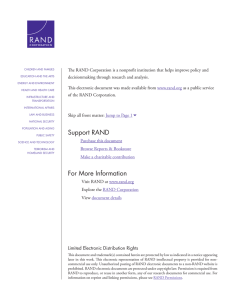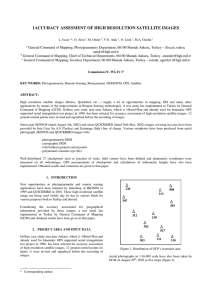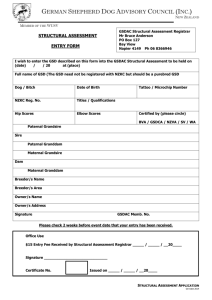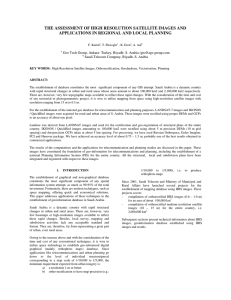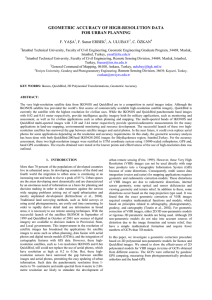IMAGE-BASED ESTIMATION AND VALIDATION OF NIIRS FOR HIGH-RESOLUTION SATELLITE IMAGES of Korea,
advertisement
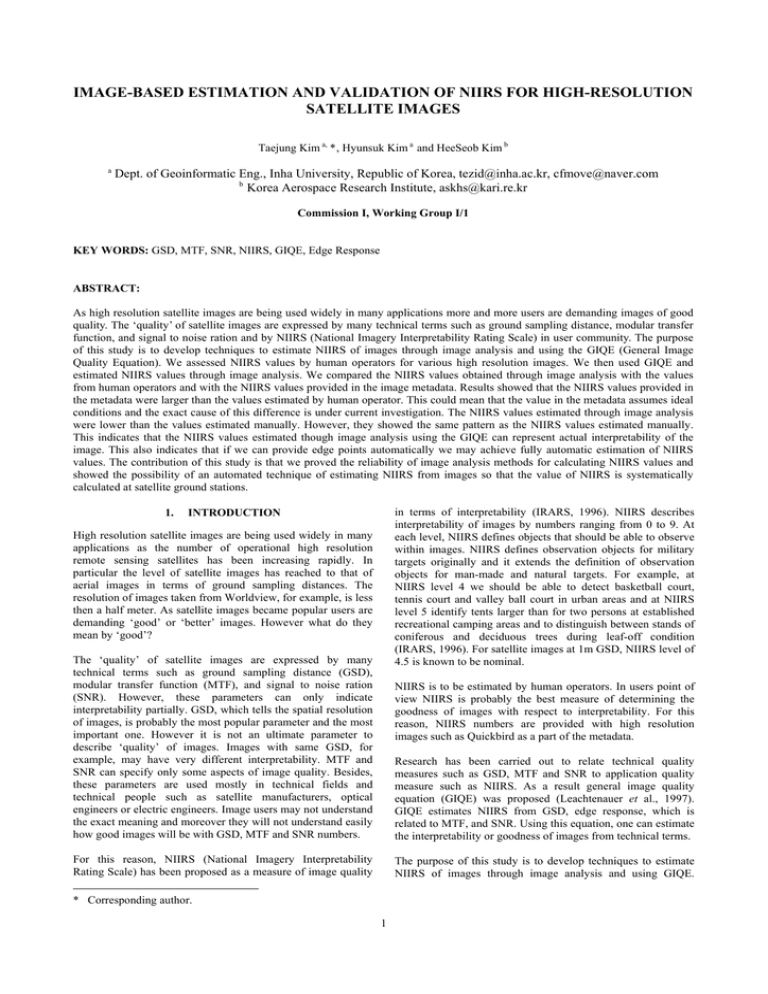
IMAGE-BASED ESTIMATION AND VALIDATION OF NIIRS FOR HIGH-RESOLUTION SATELLITE IMAGES Taejung Kim a, *, Hyunsuk Kim a and HeeSeob Kim b a Dept. of Geoinformatic Eng., Inha University, Republic of Korea, tezid@inha.ac.kr, cfmove@naver.com b Korea Aerospace Research Institute, askhs@kari.re.kr Commission I, Working Group I/1 KEY WORDS: GSD, MTF, SNR, NIIRS, GIQE, Edge Response ABSTRACT: As high resolution satellite images are being used widely in many applications more and more users are demanding images of good quality. The ‘quality’ of satellite images are expressed by many technical terms such as ground sampling distance, modular transfer function, and signal to noise ration and by NIIRS (National Imagery Interpretability Rating Scale) in user community. The purpose of this study is to develop techniques to estimate NIIRS of images through image analysis and using the GIQE (General Image Quality Equation). We assessed NIIRS values by human operators for various high resolution images. We then used GIQE and estimated NIIRS values through image analysis. We compared the NIIRS values obtained through image analysis with the values from human operators and with the NIIRS values provided in the image metadata. Results showed that the NIIRS values provided in the metadata were larger than the values estimated by human operator. This could mean that the value in the metadata assumes ideal conditions and the exact cause of this difference is under current investigation. The NIIRS values estimated through image analysis were lower than the values estimated manually. However, they showed the same pattern as the NIIRS values estimated manually. This indicates that the NIIRS values estimated though image analysis using the GIQE can represent actual interpretability of the image. This also indicates that if we can provide edge points automatically we may achieve fully automatic estimation of NIIRS values. The contribution of this study is that we proved the reliability of image analysis methods for calculating NIIRS values and showed the possibility of an automated technique of estimating NIIRS from images so that the value of NIIRS is systematically calculated at satellite ground stations. 1. in terms of interpretability (IRARS, 1996). NIIRS describes interpretability of images by numbers ranging from 0 to 9. At each level, NIIRS defines objects that should be able to observe within images. NIIRS defines observation objects for military targets originally and it extends the definition of observation objects for man-made and natural targets. For example, at NIIRS level 4 we should be able to detect basketball court, tennis court and valley ball court in urban areas and at NIIRS level 5 identify tents larger than for two persons at established recreational camping areas and to distinguish between stands of coniferous and deciduous trees during leaf-off condition (IRARS, 1996). For satellite images at 1m GSD, NIIRS level of 4.5 is known to be nominal. INTRODUCTION High resolution satellite images are being used widely in many applications as the number of operational high resolution remote sensing satellites has been increasing rapidly. In particular the level of satellite images has reached to that of aerial images in terms of ground sampling distances. The resolution of images taken from Worldview, for example, is less then a half meter. As satellite images became popular users are demanding ‘good’ or ‘better’ images. However what do they mean by ‘good’? The ‘quality’ of satellite images are expressed by many technical terms such as ground sampling distance (GSD), modular transfer function (MTF), and signal to noise ration (SNR). However, these parameters can only indicate interpretability partially. GSD, which tells the spatial resolution of images, is probably the most popular parameter and the most important one. However it is not an ultimate parameter to describe ‘quality’ of images. Images with same GSD, for example, may have very different interpretability. MTF and SNR can specify only some aspects of image quality. Besides, these parameters are used mostly in technical fields and technical people such as satellite manufacturers, optical engineers or electric engineers. Image users may not understand the exact meaning and moreover they will not understand easily how good images will be with GSD, MTF and SNR numbers. NIIRS is to be estimated by human operators. In users point of view NIIRS is probably the best measure of determining the goodness of images with respect to interpretability. For this reason, NIIRS numbers are provided with high resolution images such as Quickbird as a part of the metadata. Research has been carried out to relate technical quality measures such as GSD, MTF and SNR to application quality measure such as NIIRS. As a result general image quality equation (GIQE) was proposed (Leachtenauer et al., 1997). GIQE estimates NIIRS from GSD, edge response, which is related to MTF, and SNR. Using this equation, one can estimate the interpretability or goodness of images from technical terms. For this reason, NIIRS (National Imagery Interpretability Rating Scale) has been proposed as a measure of image quality The purpose of this study is to develop techniques to estimate NIIRS of images through image analysis and using GIQE. * Corresponding author. 1 The International Archives of the Photogrammetry, Remote Sensing and Spatial Information Sciences. Vol. XXXVII. Part B1. Beijing 2008 Firstly, we assess NIIRS values by human operators for various high resolution images and compare the values with the NIIRS provided in the metadata of satellite images. Secondly, we use GIQE and estimate NIIRS values through image analysis. We will compare the NIIRS value obtained through image analysis with the value from human operators. Our ultimate goal is to develop a technique for automated estimation of NIIRS values. This should be feasible once the validity of the image based estimation of NIIRS is proven. have assumed idea situations when predicting NIIRS levels for their images. 2. While NIIRS values are to be estimated by human operator, research has been carried out to relate NIIRS with other image quality measures, such as GSD, MTF and SNR. As a result, Leachtenauer et al. proposed the relationship between NIIRS and other image quality measures as below The exact cause of the difference between PNIIRS and TNIIRS requires further investigation. We assumed the TNIRS as the reference and proceeded the next experiments. 3. DATASET AND MANUAL ESTIMATION OF NIIRS For experiments we used two IKONOS image and four Quickbird images. The following table summarizes the properties of images used. For Quickbird images predicted NIIRS (PNIIRS) values were provided within the metadata. For IKONOS images, NIIRS values were not included in metadata explicitly. Instead we used the published NIIRS values. Note that GSDs for the same satellite images were different to each other due to their different viewing angles. Image Type Quickbird 1 Quickbird 2 Quickbird 3 Quickbird 4 IKONOS 1 IKONOS 2 Acquisition Date 24 Sept. 2002 2 Nov. 2002 15 Jan 2005 15 Jan 2005 7 Feb. 2002 7 Feb. 2002 GSD(m) 0.6994 0.6797 0.7509 0.7661 0.9295 0.9099 NIIRS = 10.251 − a log10 GSDGM + b log10 RERGM − (0.656 ∗ H ) − (0.344 ∗ G / SNR) where RER is regularized edge response, H the overshoot and G the sum of MTF correction kernels. PNIIRS 4.3 4.4 4.5 4.5 (4.5) (4.5) RER can be measured by analysing the slopes of edge profiles within the image and this value represents MTF characteristics of the image (Blonski et al., 2006). For calculating RER, we normalized the magnitude of edge responses from 0 to 1 and produced nominal edge responses by averaging out individual edge responses (see figure 1). Then we assume the position at which normalized edge response is 0.5 as the center of edge and calculate the differences of edge responses at +0.5 and -0.5 pixels from the edge center in X direction (ERx) and Y direction (ERy). RER can be calculated as a geometric mean of Ex and Ey (Blonski et al., 2006) as below. Table 1. Characteristics of images used for experiments. These six images were used for estimating NIIRS levels by human operators. From each image, seven sub-images containing geographic or man-made features were extracted. Four human operators were analysed a NIIRS level for each sub-image by observing the features within the sub-image and the NIIRS visibility tables provided by IRARS (1996). Final NIIRS level for one image was determined by taking an average of the NIIRS levels estimated for seven sub-images from four operators. Table 2 shows the NIIRS values so-estimated. In this paper we regard this as “true” NIIRS (and hence refered to as TNIIRS hereafter). Image Type Quickbird 1 Quickbird 2 Quickbird 3 Quickbird 4 IKONOS 1 IKONOS 2 PNIIRS 4.3 4.4 4.5 4.5 (4.5) (4.5) NIIRS ESTIMATION THROUGH IMAGE ANALYSIS RERGM = [ERx (0.5) − ERx (−0.5)][ERy (0.5) − ERy (−0.5)] TNIIRS 3.71 3.75 3.93 3.75 3.53 3.52 Table 2. NIIRS provided in the metadata (PNIIRS) and estimated by human operators (TNIIRS) Figure 1. Calculation of RER (Blonski et al., 2006) There is a significant difference between PNIIRS and TNIIRS. Whereas the values published within the metadata were closer to the nominal values, the actual values estimated by human operators were much smaller. This could be because unexperienced operators estimated the value. Experienced operators should identify features better and hence score NIIRS level higher. On the other hands, satellite image providers may H and G are included within GIQE to take the side effect of MTF correction into account. In general MTF correction will increase the overshoot within edge profile. For calculating H, we first calculate the maximum values at +1 to +3 pixels from the edge center within the edge response in x and y direction 2 The International Archives of the Photogrammetry, Remote Sensing and Spatial Information Sciences. Vol. XXXVII. Part B1. Beijing 2008 It was difficult to have actual accurate values for G since this value was not provided within the metadata, For IKONOS we used the value published in the literature (Ryan et al., 2003) and for Quickbird we assumed the value for IKONOS. For SNR we assumed a constant value of 10. Although there are ways of analysing SNR from the image, this method was not hired in our experiments. (see figure 2) when there is an overshoot (case 1 in figure 2). If there is an undershoot, the values are defined as the value at +1.25 pixel from the edge center. As before, H is defined as the geometric mean of the overshoot in x and y directions. Table 3 shows the NIIRS estimated through image analysis as explained so far. Image Type Quickbird 1 Quickbird 2 Quickbird 3 Quickbird 4 IKONOS 1 IKONOS 2 RER 0.2135 0.2043 0.2711 0.2515 0.2444 0.2233 H 0.7783 0.7735 0.7832 0.7668 0.7939 0.7765 G 4.16 4.16 4.16 4.16 4.16 4.16 GSD 0.6994 0.6797 0.7509 0.7661 0.9295 0.9099 INIIRS 3.16 3.15 3.34 3.23 3.01 2.92 Table 3. Estimation of Image-based NIIRS (INIIRS) Table 4 summarizes the three types of NIIRS: the NIIRS provided within image metadata (PNIIRS), the NIIRS estimated by human operator (TNIIRS) and the NIIRS estimated through image analysis (INIIRS). Figure 1. Calculation of H (Leachtenaucer et al., 1997) In order to calculate NIIRS through image analysis (Imagebased NIIRS, INIIRS hereafter), we first selected points manually where intensities were changing rapidly. Edge profiles around the edge points provided were calculated. Figure 1 shows the example of edge points provided manually for edge response generation. Image Type Quickbird 1 Quickbird 2 Quickbird 3 Quickbird 4 IKONOS 1 IKONOS 2 PNIIRS 4.3 4.4 4.5 4.5 (4.5) (4.5) TNIIRS 3.71 3.75 3.93 3.75 3.53 3.52 INIIRS 3.16 3.15 3.34 3.23 3.01 2.92 Table 4. Comparison of PNIIRS, TNIIRS and INIIRS We can observe that INIIRS values were significantly lower then PNIIRS and TNIIRS values. There can be many reasons for this error. The G and SNR values we used may not be very precise. (In fact SNR value of 10 was too small.) If we use larger SNR value and smaller G, INIIRS value will increase. At optimum situation, infinite SNR number can increase NIIRS value by 0.344. Also table 4 indicates that RER and H values we estimated may contain errors. There may be some errors in taking averages of edge responses and calculating nominal edge responses. This effect is currently under investigation. On the other hand, we estimated the edge responses (and RER and H) from natural targets. In this case, edge responses may not be in a perfect shape compared to the case tarps, for example, were used. RER values in ideal case should be larger than the ones estimated here. Figure 3. Example of edge points used for edge profile generation Figure 4 plots the three NIIRS values for the six images used for experiments. The figure shows very interesting results. As mentioned earlier, TNIIRS values were lower than PNIIRS values and there is no correlation between PNIIRS and TNIIRS (“NIIRS Inspection” in the figure). However INIIRS values (“NIIRS by hand” in the figure) showed strong correlation with TNIIRS. Although there were shifts between TNIIRS and INIIRS, the amounts of the shifts were almost constant. This For one image, around 20 edge points were provided and for each point, an edge profile was created. All edge profiles within one image were averaged out to create nominal edge responses for the image. Nominal edge responses were used to calculate RER and H values. 3 The International Archives of the Photogrammetry, Remote Sensing and Spatial Information Sciences. Vol. XXXVII. Part B1. Beijing 2008 NIIRS from images so that the value of NIIRS is systematically calculated at satellite ground stations. means that the NIIRS values estimated through image analysis may indicate the true interpretability of the image. 4. REFERENCES CONCLUSIONS AND FUTURE WORK IRARS Committee, 1996. Civil NIIRS Reference Guide. http://www.fas.org/irp/imint/niirs_c/index.html (accessed 30 April 2008) So far, we described experiments carried out to compare the NIIRS values provided in the image metadata, the NIIRS values estimated by human operator and the NIIRS values estimated through image analysis. The NIIRS values provided in the metadata were larger than the values estimated by human operator. This could mean that the value in the metadata assumes ideal conditions and the exact cause of this difference is under current investigation. Leachtenauer, J. C., Malila, W., Irvine, J., and Colburn, L., 1997. General Image-Quailty Equation: GIQE. Applied Optics, 36(32):8322~8328 Blonski, S., Ross, K., Pagnutti, M., and Stanley, T., 2006, Spatial Resolution Characterization for Aerial Digital Imagery. SSTI-2220-0071, NASA Technical Report Server http://ntrs.nasa.gov (accessed 30 April 2008) The NIIRS values estimated through image analysis were lower than the values estimated manually. However, they showed the same pattern as the NIIRS values estimated manually, indicating that the NIIRS values estimated though image analysis using the General Image Quality Equation can represent actual interpretability of the image. This also indicates that if we can provide edge points automatically we may achieve fully automatic estimation of NIIRS values. Precondition for this conclusion is that we need to find out the cause of deviation in the NIIRS values through image analysis and the values from human operators. This is under current investigation. Ryan, R., Baldridge, B., Schowengerdt, R. A., Choi, T., Helider, D. L., and Blonski, S., 2003. IKONOS spatial resolution and image interpretability characterization. Remote Sensing of Environment, 88(01):37-52 ACKNOWLEDGEMENTS The work in the paper is supported by research grant from “Kompsat-3 System Development Project” of Korea Aerospace Research Institute. The contribution of this study is that we proved the reliability of image analysis methods for calculating NIIRS values and showed the possibility of an automated technique of estimating Comparison of PNIIRS, TNIIRS and INIIRS 5 4.5 NIIRS 4 PNIIRS NIIRS Inspection NIIRS by hand 3.5 3 2.5 2 QB001 QB002 QB003 QB004 IK001 IK002 Figure 4. Comparison of PNIIRS, TNIIRS and INIIRS 4
